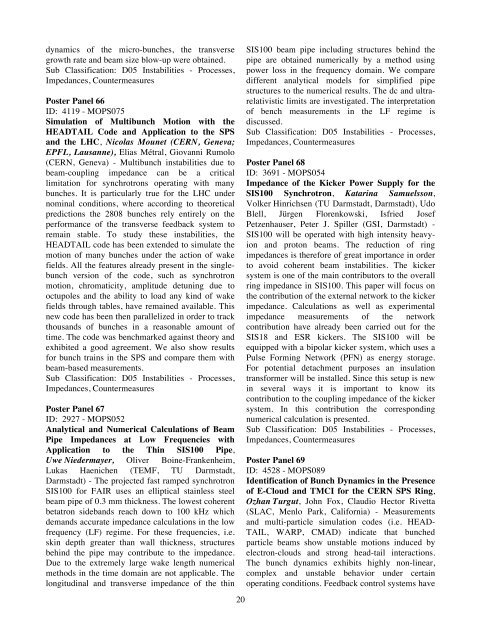Abstracts Brochure - 2nd International Particle Accelerator Conference
Abstracts Brochure - 2nd International Particle Accelerator Conference
Abstracts Brochure - 2nd International Particle Accelerator Conference
You also want an ePaper? Increase the reach of your titles
YUMPU automatically turns print PDFs into web optimized ePapers that Google loves.
dynamics of the micro-bunches, the transverse<br />
growth rate and beam size blow-up were obtained.<br />
Sub Classification: D05 Instabilities - Processes,<br />
Impedances, Countermeasures<br />
Poster Panel 66<br />
ID: 4119 - MOPS075<br />
Simulation of Multibunch Motion with the<br />
HEADTAIL Code and Application to the SPS<br />
and the LHC, Nicolas Mounet (CERN, Geneva;<br />
EPFL, Lausanne), Elias Métral, Giovanni Rumolo<br />
(CERN, Geneva) - Multibunch instabilities due to<br />
beam-coupling impedance can be a critical<br />
limitation for synchrotrons operating with many<br />
bunches. It is particularly true for the LHC under<br />
nominal conditions, where according to theoretical<br />
predictions the 2808 bunches rely entirely on the<br />
performance of the transverse feedback system to<br />
remain stable. To study these instabilities, the<br />
HEADTAIL code has been extended to simulate the<br />
motion of many bunches under the action of wake<br />
fields. All the features already present in the singlebunch<br />
version of the code, such as synchrotron<br />
motion, chromaticity, amplitude detuning due to<br />
octupoles and the ability to load any kind of wake<br />
fields through tables, have remained available. This<br />
new code has been then parallelized in order to track<br />
thousands of bunches in a reasonable amount of<br />
time. The code was benchmarked against theory and<br />
exhibited a good agreement. We also show results<br />
for bunch trains in the SPS and compare them with<br />
beam-based measurements.<br />
Sub Classification: D05 Instabilities - Processes,<br />
Impedances, Countermeasures<br />
Poster Panel 67<br />
ID: 2927 - MOPS052<br />
Analytical and Numerical Calculations of Beam<br />
Pipe Impedances at Low Frequencies with<br />
Application to the Thin SIS100 Pipe,<br />
Uwe Niedermayer, Oliver Boine-Frankenheim,<br />
Lukas Haenichen (TEMF, TU Darmstadt,<br />
Darmstadt) - The projected fast ramped synchrotron<br />
SIS100 for FAIR uses an elliptical stainless steel<br />
beam pipe of 0.3 mm thickness. The lowest coherent<br />
betatron sidebands reach down to 100 kHz which<br />
demands accurate impedance calculations in the low<br />
frequency (LF) regime. For these frequencies, i.e.<br />
skin depth greater than wall thickness, structures<br />
behind the pipe may contribute to the impedance.<br />
Due to the extremely large wake length numerical<br />
methods in the time domain are not applicable. The<br />
longitudinal and transverse impedance of the thin<br />
�<br />
20<br />
SIS100 beam pipe including structures behind the<br />
pipe are obtained numerically by a method using<br />
power loss in the frequency domain. We compare<br />
different analytical models for simplified pipe<br />
structures to the numerical results. The dc and ultrarelativistic<br />
limits are investigated. The interpretation<br />
of bench measurements in the LF regime is<br />
discussed.<br />
Sub Classification: D05 Instabilities - Processes,<br />
Impedances, Countermeasures<br />
Poster Panel 68<br />
ID: 3691 - MOPS054<br />
Impedance of the Kicker Power Supply for the<br />
SIS100 Synchrotron, Katarina Samuelsson,<br />
Volker Hinrichsen (TU Darmstadt, Darmstadt), Udo<br />
Blell, Jürgen Florenkowski, Isfried Josef<br />
Petzenhauser, Peter J. Spiller (GSI, Darmstadt) -<br />
SIS100 will be operated with high intensity heavyion<br />
and proton beams. The reduction of ring<br />
impedances is therefore of great importance in order<br />
to avoid coherent beam instabilities. The kicker<br />
system is one of the main contributors to the overall<br />
ring impedance in SIS100. This paper will focus on<br />
the contribution of the external network to the kicker<br />
impedance. Calculations as well as experimental<br />
impedance measurements of the network<br />
contribution have already been carried out for the<br />
SIS18 and ESR kickers. The SIS100 will be<br />
equipped with a bipolar kicker system, which uses a<br />
Pulse Forming Network (PFN) as energy storage.<br />
For potential detachment purposes an insulation<br />
transformer will be installed. Since this setup is new<br />
in several ways it is important to know its<br />
contribution to the coupling impedance of the kicker<br />
system. In this contribution the corresponding<br />
numerical calculation is presented.<br />
Sub Classification: D05 Instabilities - Processes,<br />
Impedances, Countermeasures<br />
Poster Panel 69<br />
ID: 4528 - MOPS089<br />
Identification of Bunch Dynamics in the Presence<br />
of E-Cloud and TMCI for the CERN SPS Ring,<br />
Ozhan Turgut, John Fox, Claudio Hector Rivetta<br />
(SLAC, Menlo Park, California) - Measurements<br />
and multi-particle simulation codes (i.e. HEAD-<br />
TAIL, WARP, CMAD) indicate that bunched<br />
particle beams show unstable motions induced by<br />
electron-clouds and strong head-tail interactions.<br />
The bunch dynamics exhibits highly non-linear,<br />
complex and unstable behavior under certain<br />
operating conditions. Feedback control systems have


